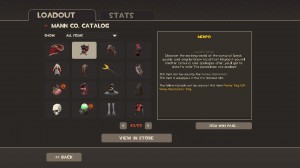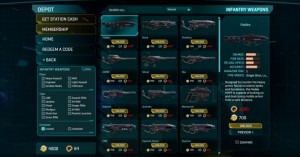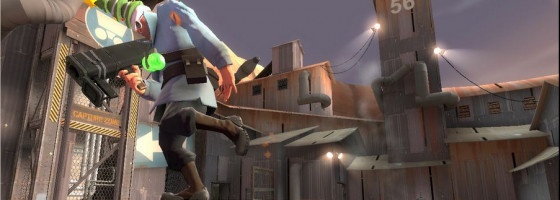Meta game progression is the design of adding permanence between different plays of a game. Over the course of the last decade it has flourished with Team Fortress 2 leading the way. The mechanic of adding new items, both cosmetic and functional gave players a reason to stick around.
The popularity of Team Fortress 2 did not go unnoticed and since then, more multiplayer titles are being designed with a Meta game in mind: from League of Legends, to Call of Duty and many more. In one way this is good, as it helps to keep a multiplayer community going for a longer period of time. However while it’s great for games that make use of it, what happens to those that don’t?
The Old Days:
Before Team Fortress 2 started adding Meta game design to multiplayer, most shooters had a limited shelf life with the mainstream audiences. The only thing that was tracked between matches was the basic stats of the player: Win/Lost, enemy’s killed etc. Without any form of outside improvement for in-game characters, the skill ceiling of older shooters was very high.
If you wanted to start playing a new multiplayer game several months after its release, prepared to be overwhelmed with expert players gunning you down, who have been playing the game every day. As due to the limits of progression, most casual and mainstream fans won’t stay around for the long run leaving you with the people who have been learning the maps and gameplay for months.
Because of this, most multiplayer games barely stayed active beyond a year after release. They are still being played, but by a minority of expert players.
Hat Power:
When Team Fortress 2 was first released as a part of The Orange Box, it had the same lack of permanence between matches that every other shooter had before it. But Valve decided to change that, first with achievement only items. Over the next few years this blossomed into hats, timed drops, crafting, trading, the item store and now being free to play.
Today, Team Fortress 2 is a completely different game then it was in its first year. And as we’re talking now, Valve has just released the marketplace beta where you could now sell Team Fortress 2 items for Steam Wallet Cash, which can be used on anything on Steam.

Natural Selection 2 was one of only a few multiplayer only games released in 2012 without any Meta-game content.
Speaking about the first year, Team Fortress 2 has beaten the curve for multiplayer shooters and is over five years old.
With that success, we have seen a number of new games aimed to deliver that same level of persistence.
What’s interesting is that these games run the spectrum of AAA developed games (Call of Duty), Indie games (Guns of Icarus Online) and free to play (League of Legends).
On one hand the success of Team Fortress 2‘s Meta game has helped keep it full of active players. But there are plenty of people who have stopped playing because of it. The problems for the critics of Team Fortress 2 are twofold.
First, is that the skill curve of playing Team Fortress 2 has gone down with the inclusion of items. The reason is that the more character progression items available, downplays the player’s skill. For player’s who like their own skill at the game to be the best factor at winning, items tend to muddle the results.
This is also something that we see in other games built around Meta-game design or free to play. Where, a player with a high skill level is weaker compared to someone who has played the game more and has accumulated more items. While Valve has done an admirable job in keeping balance in Team Fortress 2, the items themselves have become a barrier to some.

Team Fortress 2’s inventory system has steadily gotten more advanced and has become a major incentive to play.
The other problem with Team Fortress 2 is that while the inclusion of items has become a major element of the game, they are still divorced from the result of playing.
Winning or losing a round or a match has no bearing on item unlocks or rewards. This has made the act of actually playing Team Fortress 2 for some people, into a side activity with a focus on in items.
For long time players, many felt that the increased focus on items and content took away from playing the game and diluted the experience. And that collecting items have become the main focus instead of the team vs. team matches.
Now, you would think that the simplest solution would be to just create a multiplayer game without any persistence, but as we’ve also seen that has its own share of problems.
A Return to the Old Days:
While the thought of having a complex multiplayer game without any persistence looks good on paper. In today’s world, it can be seen as archaic.
Returning to the days where multiplayer games never change or grow is great for the expert players or the people who play it every day. But now, with everything from Team Fortress 2 to Call of Duty and so on offering a sense of permanence, it’s hard to go back to the old days.
Recently I tried playing Natural Selection 2: a team vs. team shooter with asymmetrical sides with some strategy game mechanics. The game definitely tries something different compared to other team based shooters on the market. However, without permanence, the matches started to blend together after awhile and it felt like I was just doing the same thing over again.
What’s worse is that for someone who plays other titles like Team Fortress 2 or Planetside 2, it can feel like you’re wasting your time playing a game like Natural Selection 2 where you have these other games that give you more things to do the more you play.
And once you’ve reached a point where you’ve seen everything the game has to offer, there is no other reason to keep playing outside of for competitive purposes. This is great for expert players, but once again leaves the game difficult for someone new learning how to play.
“As a general rule: If the Meta content in some way trivializes actually playing the game, this should be avoided at all costs.”
So far we’ve talked about the issues of no meta-game content, but for our last point, balancing both meta-game and micro transaction content can be just as tricky.
The dreaded “Pay to Win”:
The challenge of designing a balanced meta-game system is determining how important skill is over the Meta game or micro transaction model. This is one area that Valve has largely succeeded with Team Fortress 2. While there is a lot of Meta game content, skill is still an important factor of winning.
It doesn’t matter what rocket launcher you have for the solider if you can’t aim properly in the first place. This is primarily due to the items in Team Fortress 2 acting as side-grades instead of full blown upgrades for your character.
But if the meta-game content is designed around upgrades, then we see signs of “pay to win” coming into the picture.

Planetside 2′s store offers a bevy of items to purchase. Always giving players something new to look forward to.
In Planetside 2, players can use credits which are earned by completing objectives and killing enemies to buy new gear, or enhance ones already unlocked.
Items can also be bought using station cash AKA purchasable currency.
The issue is that the items that you can buy in PlanetSide 2 are pure upgrades compared to what you start out with. Leaving you with the choice to either spend a lot of time with less than adequate weapons to get the credits and upgrades needed, or spend money and get better items fast.
In many cases, it doesn’t matter how skilled or accurate you are, if you’re using a crappy weapon to begin with. Getting the drop on another player to then discover that they are a much higher level then you and can kill you easily is not a good time.
What ends up happening is a similar situation that we see in games without a meta-game: Where the longer you wait to play, the more the skill gap widens. But in a game with purchasable content it’s the Meta content gap that gets worse.
When someone new starts playing to find that everyone already has bought better gear and they are at a huge disadvantage that becomes worse the longer the game is out.
Being Both Designer and Accountant:
As we can see, the scope of multiplayer games has changed radically over the last decade. A new goal for designers is to keep their respective game being played for a long period of time by giving incentives to the players.
In cases like League of Legends and Team Fortress 2: It has given games a strong community. But if done incorrectly or not at all, it can hurt the game’s life span and drive people away from a title instead of pulling them in.
Creating a strong meta-game is not as simple as having an in-game store and sitting there waiting for cash to come in. It has to be integrated meaningfully into the gameplay while still allowing people who don’t (or can’t) spend money to progress.

Regardless of the item variety in Team Fortress 2, there are no items that will take the place of skill.
The allure of creating pure upgrades for cash is a strong one, but at the same time it can lead to short term gain, for long term lost of your player-base.
This is why cosmetic items are the most popular: as they provide incentives, without upsetting gameplay. As a general rule: If the Meta content in some way trivializes actually playing the game, this should be avoided at all costs.
The focus of getting your attention (and money) when playing online games has never been greater and will only become larger as more games are released; both designers and players need to watch out for meta-game content that only benefits one side. Like the recent fiasco behind War Z showed: micro transactions do not make a game better… or finished for that matter.


